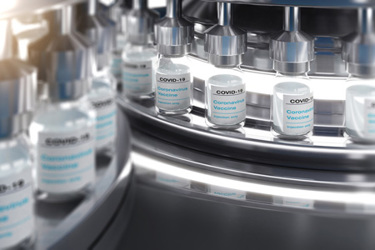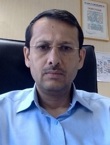How Serum Institute Delivered A 'Breath Of Relief' In 6 Months
A conversation with Kedar Gokhale, executive director, Serum Institute of India

Bioprocess Online and ISPE are collaborating to showcase the 2023 ISPE Facility of the Year (FOYA) sponsor company winners. In a limited series, we hear from industry leaders at three companies, Genentech, Serum Institute, and Takeda, which all earned awards.
For its rapid pandemic response, Serum Institute of India won awards in two categories, supply chain and social impact. As the world’s largest vaccine manufacturer, their contribution to the response was probably expected. It was the skill and speed at which the company reacted, however, that earned the awards.
Serum redirected an unfinished construction project, later named Nishwas, and started producing the Oxford-AstraZeneca vaccine in record time.
Serum decided to pivot on Oct. 1, 2020. Six months later, almost to the day, finished product was rolling out the door. It would go on to protect patients in more than 90 nations — many of which are poor and developing.
We asked Kedar Gokhale, an executive director at Serum, about the undertaking and the lessons they learned along the way.
Bioprocess Online: The COVID-19 response record is filled with stories of logistical gymnastics. What factors led Serum Institute to redirect a nearly finished construction project and enter the fray?
Gokhale: During the pandemic, there was an urgent need to manufacture a COVID vaccine to save lives. Dedicating resources to development and distribution in tandem with other priority vaccines, such as polio or pneumonia, was a challenge, but as the COVID virus continued to spread across the globe, it was clear a massive response was needed.
Serum manufactures and distributes billions of vaccine doses each year, dosing an estimated one in every three children. Our mission is to protect people at every stage of life, so our team felt a need to help during the pandemic in any way we could. Our Nishwas facility was already being built with global distribution in mind, designed to meet the standards of a variety of regulatory agencies such as the MHRA and FDA.
We’re fortunate that our facility was already primed for this type of project; however, “business” was the last thing on our team’s mind when making the decision to convert Nishwas to COVID vaccine production. People were dying.
After the facility was complete, we named it Nishwas, which translates to “the breath of relief,” as a reminder of the impact of our work and the relief it provided in a time of global need.
Bioprocess Online: Early in the pandemic, global leaders identified India as a key player in the response and a lifeline for developing countries. Looking back, how did it measure up to expectations, and where is there room for continued improvement?
Gokhale: Serum was instrumental in getting vaccines to remote areas of the world – a true challenge when doses must be kept at specific temperatures in order to remain effective. Our teams worked with Oxford-AstraZeneca to reformulate their COVID vaccine to raise the storage temperature by performing a variety of stability tests. By doing so, we were able to reach and vaccinate more of the developing world.
Looking back at the COVID response, I think the scientific community and biopharma industries were challenged in ways we didn’t anticipate. Now, our goal must be to learn from this experience and prepare, which is why Serum is building a pandemic preparedness facility to support the world during any future pandemics. Facility construction is in underway.
Bioprocess Online:Talk about the biggest manufacturing challenges and how Serum approached them.
There are always deadlines during the construction of new facilities, but this deadline was different — people’s lives were on the line, and that added a sense of urgency for everyone. Constructing the facility while simultaneously trying to avoid mass outbreaks of COVID was also a challenge. Precautionary measures like staggered working hours, hand sanitization stations, routine medical checks, and avoiding group activities like meetings were taken.
We also needed to bring in specialists from outside the country to assist with construction — roughly 100 technicians were brought in from abroad.
Special permission was obtained from the government of India to bring technicians from abroad for equipment installations and qualifications. We also contracted around 600 local contractors to assist, and they were asked to designate groups for the Serum activities so that they were not exposed to the outside environment. Serum provided help in arranging isolated stays for the contractors. Also, food was provided for them during the lockdown period, even during non-working hours.
Bioprocess Online: Likewise, what were the biggest supply chain obstacles? How did you overcome those?
Gokhale: Suppliers and partners were made aware of the situation. They also geared up to face this challenge to save lives. Materials were made available by giving priority to this cause. OEMs extended their support by sending technicians for qualification of the equipment. Suppliers were briefed on requirements and Serum helped them to get special permission to operate abroad during the lockdown. This helped them to supply material to Serum for vaccine manufacturing. After manufacturing the COVID vaccine, we now had to distribute it globally. Working with Oxford-AstraZeneca to raise the storage temperature was an unexpected obstacle that was necessary to reach the developing world as we navigated supply chain challenges.
Making sure we had the right packaging for our raw material was critical to global distribution, and supply was running low during the pandemic. Serum had a good stockpile of packaging material already, and leadership coordinated packing supply early on to ensure stopper seals and other primary packaging materials would be ready once the vaccine was manufactured.
Large-scale cold chain distribution was used by Serum to ensure the vaccine reached all corners of the world, working with regulatory agencies from over 100 nations.
Bioprocess Online: What does Serum Institute's success with the COVID-19 vaccine say about the company and India's position in the global vaccine landscape?
Gokhale: Serum has been manufacturing lifesaving vaccines for over 50 years, and we take great pride in knowing that we’re able to serve humanity. Our team worked incredibly hard to supply billions of vaccine doses in record time, leveraging our years of experience when it mattered most.
Our ability to take on this challenge — pivoting part way through the construction of our newest facility — shows the dedication and flexibility of the organization. As a country, we take great pride in knowing that this vaccine was manufactured in India, a nation filled with hardworking, helpful people.
The Indian government had also supplied millions of doses to neighboring countries under the Vaccine Maitri program, indicating friendship. We’re very honored to be recognized by FOYA for our Nishwas facility, a project that many of us will remember for a lifetime.
About The Expert: 
Kedar Gokhale is an executive director at Serum Institute of India, where he has worked since 2008. He has about 30 years of experience in the pharmaceutical industry and has managed complex and international facility engineering projects primarily for injectables, including vaccines and monoclonal antibodies.

